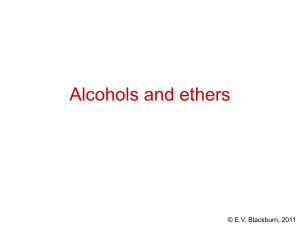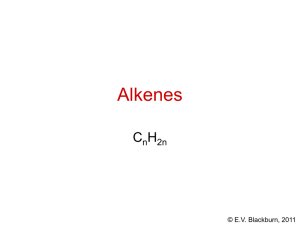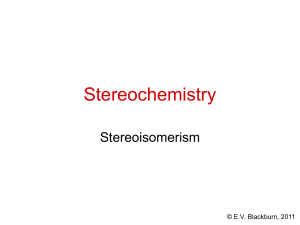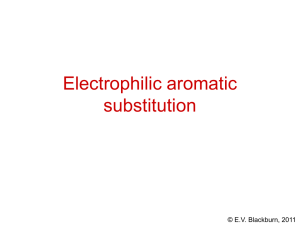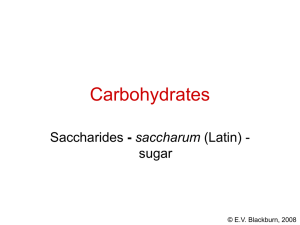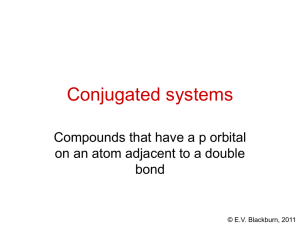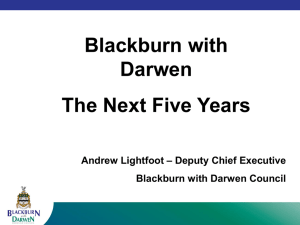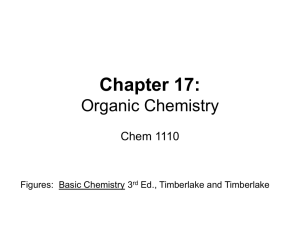Alcools
advertisement
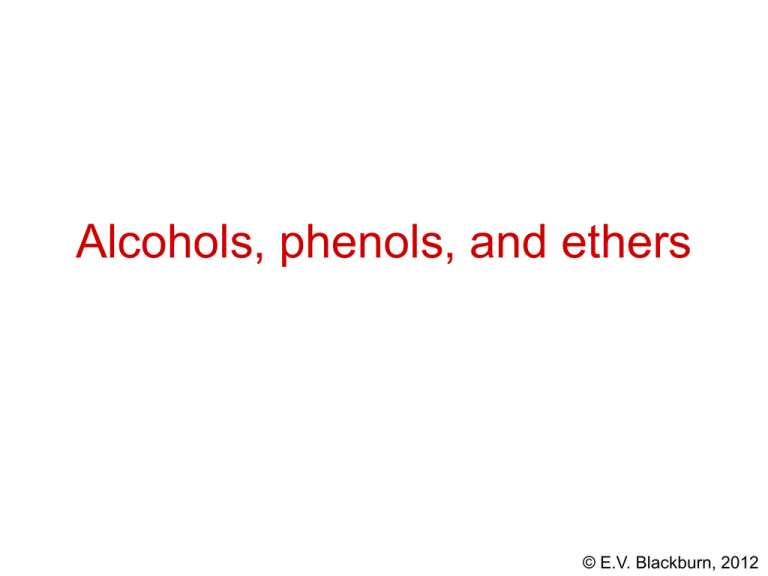
Alcohols, phenols, and ethers © E.V. Blackburn, 2012 Structure R-OH alcohol R = alkyl group (substituted or unsubstituted) H R C OH H R' R C OH H 1o 2o R' R C OH R" 3o © E.V. Blackburn, 2012 Nomenclature of alcohols Add the suffix ol to the name of longest, linear, carbon chain which includes the carbon bearing the OH and any double or triple C-C bond. The OH group has a higher priority than a multiple CC bond, a halogen, and an alkyl group in determining the carbon chain numbering. 5-phenyl-2-hexanol OH © E.V. Blackburn, 2012 Nomenclature of alcohols CH2CH2OH CH3CH=CHCH2CH2OH 3-penten-1-ol 2-phenylethanol F OH trans-3-fluorocyclohexanol © E.V. Blackburn, 2012 Nomenclature of alcohols OH O H3C C C H OH 2-hydroxypropanoic acid © E.V. Blackburn, 2012 Nomenclature of alcohols CH2CH2CH3 H3CH2C OH H 3-hexanol? © E.V. Blackburn, 2012 Cahn - Prelog - Ingold rules Step 1: assign a priority to the 4 atoms or groups of atoms bonded to the stereogenic carbon: 1. If the 4 atoms are all different, priority is determined by atomic number. The atom of higher atomic number has the higher priority. H HO NH 2 CH3 © E.V. Blackburn, 2012 Determination of priority 2. If priority cannot be determined by (1), it is determined by a similar comparison of atoms working out from the stereogenic carbon. 4 H H H H H C C C H H H Cl H 1 In the methyl group, the second atoms are H, H, H whereas in the ethyl group, they are C, H, H. The priority sequence is therefore Cl, C2H5, CH3, H. © E.V. Blackburn, 2012 Cahn - Prelog - Ingold rules 3. A double or triple bond to an atom, A, is considered as equivalent to two or three single bonds to A: H C O H OH CH2OH H O O The sequence is therefore -OH, -CHO, -CH2OH, -H. © E.V. Blackburn, 2012 Step 2 Arrange the molecule so that the group of lowest priority is pointing away from you and observe the arrangement of the remaining groups: CH2CH3 CH2CH3 R CH3 Cl H Cl H3C H If, on going from the group of highest priority to that of second priority and then to the group of third priority, we go in a clockwise direction, the enantiomer is designated (R). © E.V. Blackburn, 2012 Step 2 CH2CH3 CH2CH3 (S) CH3 Cl H Cl H3C H If the direction is counterclockwise, the enantiomer is designated (S). Thus the complete name for one of the enantiomers of 2chlorobutane is (S)-2-chlorobutane which is, by chance, the dextrorotatory enantiomer. There is no correlation between (+)/(-) and (R)/(S). © E.V. Blackburn, 2012 R or S? Br H HO NH 2 CH3 H C O H OH CH2OH H3C H CH2CH3 OH H3CH2C CH3 H CH3 H © E.V. Blackburn, 2012 Nomenclature of alcohols Br Cl OH CH3 3-bromo-3-chloro-2-methyl-2-propen-1-ol? © E.V. Blackburn, 2012 E-Z designations Br Cl OH (Z)- 3-bromo-3-chloro-2-methyl-2-propen-1-ol CH3 • use the Cahn-Ingold-Prelog system to assign priorities to the two groups on each carbon of the double bond. • then compare the relative positions of the groups of higher priority on these two carbons. • if the two groups are on the same side, the compound has the Z configuration (zusammen, German, together). • if the two groups are on opposite sides, the compound has the E configuration (entgegen, German, across). © E.V. Blackburn, 2012 E-Z designations OH H CH H 3 © E.V. Blackburn, 2012 Sterols - the steroid ring system 12 3 11 D 16 1 C 9 14 A B 7 5 HO cholesterol © E.V. Blackburn, 2012 Physical properties of alcohols Alcohols are noticeably less volatile; their melting points are greater and they are more water soluble than the corresponding hydrocarbons having similar molecular weights. These differences are due to the OH group which renders a certain polarity to the molecule. The result is an important intermolecular attraction: - + - + O H O H O H R R R the hydrogen bond ~ 21 - 25 kJ/mol © E.V. Blackburn, 2012 Solubility of alcohols Low molecular weight alcohols are water soluble: - + - + - + O H O H O H R H R © E.V. Blackburn, 2012 Spectroscopic properties IR: Associated alcohols (hydrogen bonded) show a broad absorption in the 3300 - 3400 cm-1 range. 1H NMR: Absorption occurs in the range = 3.5 to 4.5. Coupling is not observed due to rapid H - H exchange. © E.V. Blackburn, 2012 Fermentation Fermentation of sugar by yeast gives C2H5OH. Methanol is added to denature it. © E.V. Blackburn, 2012 Azeotropic mixtures The bp of ethanol is 78.3C whereas that of water is 100C (at least on Vancouver’s waterfront!). Can we separate a mixture by distillation? No! An azeotropic mixture forms! An azeotropic mixture is one whose liquid and vapor forms have identical compositions. The mixture cannot be separated by distillation. eg C2H5OH (95%) and H2O (5%) - bp 78.13C H2O (7.5%), C2H5OH (18.5%) and C6H6 (74%) - bp 64.9C © E.V. Blackburn, 2012 Oxymercuration © E.V. Blackburn, 2012 Oxymercuration An anti addition via a mercurinium ion: CH3CO2- Dissociation: Hg(OAc) 2 + + HgOCOCH 3 + HgOCOCH 3 Electrophilic attack: CH3 + HgOCOCH 3 + HgOCOCH 3 Nucleophilic opening: CH3 H-O-H CH3 CH3 OH Hg OCOCH 3 H © E.V. Blackburn, 2012 Oxymercuration Why do we observe Markovnikov addition? + HgOAc HgOAc In the mercurinium ion, the positive charge is shared between the more substituted carbon and the mercury atom. Only a small portion of the charge resides on this carbon but it is sufficient to account for the orientation of the addition but is insufficient to allow a rearrangement to occur. © E.V. Blackburn, 2012 Hydroboration H.C. Brown and G. Zweifel, J. Am. Chem. Soc., 83, 2544 (1961) H2O2 + (BH3)2 diborane H B OH - + B(OH) 3 H OH © E.V. Blackburn, 2012 Hydroboration 1. (BH3)2 H3C 2. H2O2/OH- 3HC H syn addition H OH trans-2-methylcyclopentanol (CH3)3CCH=CH2 (CH3)3CCH2CH2OH no rearrangement no carbocation! © E.V. Blackburn, 2012 Hydroboration - the mechanism CH3CH=CH 2 CH3CH=CH2 HX 1. (BH3)2 - 2. H2O2/OH CH3CH CH3CH2CH2OH CH2 + CH3CHCH3 + X- H X © E.V. Blackburn, 2012 Hydroboration - the mechanism CH3CH=CH 2 1. (BH3)2 - 2. H2O2/OH CH3 > CH CH3 > CH H CH3CH2CH2OH CH2 H B H H CH2 B H H © E.V. Blackburn, 2012 Hydroboration - the mechanism R R B O-OH R R R -B O OH R RO B OR RO R R -B O OH R R + HO B OR R HO - 3ROH + BO 33- © E.V. Blackburn, 2012 Reduction of carbonyls © E.V. Blackburn, 2012 Reduction of carbonyls © E.V. Blackburn, 2012 Reduction of carbonyls H 3B H O H - O H 2O H O- H OH hydride transfer © E.V. Blackburn, 2012 Reduction of acids 1. LiAlH 4, THF RCH2OH RCO2H + 2. H3O 1o alcohol © E.V. Blackburn, 2012 Reduction of esters i. LiAlH 4 O R + OR' ii. H O CH3CH2CH=CHCOCH 2CH3 RCH2OH + R'OH 1. LiAlH 4 2. H+ CH3CH2CH=CHCH 2OH + CH3CH2OH © E.V. Blackburn, 2012 Reactivity of the carbonyl group R o 120 C 'R sp2 O © E.V. Blackburn, 2012 Nucleophilic addition Nu R O R' :Nu R O 'R + Nu R O R' - H 2O + Nu R O R' + Nu R OH R' © E.V. Blackburn, 2012 Preparation of alcohols Grignard synthesis dry RMgX RX + Mg ether R MgX R O - O + MgX H2O R R O - + MgX OH + Mg(OH)X © E.V. Blackburn, 2012 The Grignard reagent © E.V. Blackburn, 2012 Grignard synthesis H RMgX H C O H C OMgX H R H3O+ ' R RMgX R C O H C OMgX H R aldehyde OH primary alcohol formaldehyde ' H H R H3O+ 'R H R OH secondary alcohol © E.V. Blackburn, 2012 Grignard synthesis ' ' R RMgX R '' C O R C OMgX '' R R H3O+ ketone H O H RMgX H H ethylene oxide RCH2CH2OMgX 'R "R OH R tertiary alcohol H3O+ RCH2CH2OH primary alcohol © E.V. Blackburn, 2012 Planning a Grignard synthesis CH3 H3CH2CH2CH2C C OH © E.V. Blackburn, 2012 Limitations • Any hydrogen bonded to an electronegative element (including an acetylenic hydrogen) is sufficiently acidic to react with a Grignard reagent. CH3MgI + H2O R-CC-H + R':MgX CH4 + Mg(OH)I R-CC-MgX + R':H • Grignard reagents react with O2, CO2 and with almost all organic compounds which contain multiply bonded C-O or C-N units. © E.V. Blackburn, 2012 Reactions of alcohols The reactions of alcohols involve one of two processes: • breaking of the O-H bond • breaking of the C-O bond © E.V. Blackburn, 2012 Reactions involving O-H bond breaking RO- + M+ + 1/2 H2 R-OH + M CH3CH2OH Na CH3CH2O- Na + sodium ethoxide © E.V. Blackburn, 2012 Phenols OHArOH water insoluble H+ ArOphenoxide ion soluble Ka ~ 10-10 © E.V. Blackburn, 2012 Acidity of phenols ArOH + H2O ArO - + H3O+ © E.V. Blackburn, 2012 Acidity H+ + RO - ROH + OH + OH + OH OH OH - - O- O- O O O - - © E.V. Blackburn, 2012 Substituent effects O OH + H+ G G An electron attracting substituent stabilizes the conjugate base. The equilibrium is shifted to the right. © E.V. Blackburn, 2012 Substituent effects O OH G + H+ G Electron donating substituents reduce the acidity of phenols. © E.V. Blackburn, 2012 Substituent effects OH CH3 OH OH NO 2 © E.V. Blackburn, 2012 Reaction with hydrogen halides ROH + HX RX + H2O HX: HI > HBr > HCl ROH: allyl > 3 o > 2o > 1o < CH3OH HBr or CH3CHCH 3 OH NaBr/H 2SO4 CH3CHCH 3 Br © E.V. Blackburn, 2012 Experimental facts 1. The reaction is acid catalyzed 2. Rearrangements are possible CH3 H CH3 H HCl H3C C C CH3 H3C C C CH3 Cl H H OH 3. Alcohol reactivity is 3o > 2o > 1o < CH3OH © E.V. Blackburn, 2012 The mechanism H+ C C H OH2 + C C H OH C C H OH2 + C C H + C C H + + H2O C C H X - X SN1 © E.V. Blackburn, 2012 Reaction of primary alcohols with HX 1. ROH + HX 1o + 2. ROH2 + X- + X ROH 2 + + X R OH2 RX + H2O SN2 HX: HI > HBr > HCl This reflects nucleophile strength in a protic solvent. © E.V. Blackburn, 2012 Reactions with phosphorus halides and with thionyl chloride ROH + PX3 RX + H3PO3 SN2 RCH2Cl + SO 2 + HCl - Cl Creates a good leaving group from 1o and 2o alcohols. © E.V. Blackburn, 2012 Tosylates O CH3CH2OH + Cl S CH3 O p-toluenesulfonyl chloride B: H O + O S H3CH2C O CH3 - H +O O S H3CH2C O Cl CH3 O H3CH2CO S CH3 O ethyl p-toluenesulfonate a tosylate © E.V. Blackburn, 2012 Why form tosylates? Sulfonate ions are excellent leaving groups: Nu: O C O S O CH3 Nu C O O S O CH3 © E.V. Blackburn, 2012 Dehydration H C C OH OH H3PO4 + H 2O H3PO4/ © E.V. Blackburn, 2012 Dehydration H+ C C H OH C C H OH2 + B: C C H OH2 + C C H + C C H + + H2O C C E1 mechanism © E.V. Blackburn, 2012 Oxidation of primary alcohols RCH2OH O C5H5NHCrO 3Cl or K2Cr2O7 R H KMnO 4 or K2Cr2O7 KMnO 4 C5H5NHCrO3Cl pyridinium chlorochromate in CH2Cl2 - PCC O R OH C5H5NHCrO 3Cl CH3CH2C=O CH3CH2CH2OH CH2Cl2 H © E.V. Blackburn, 2012 Oxidation of secondary alcohols + C5H5NH CrO 3Cl, O R2CHOH K2Cr2O7, CrO3, or KMnO 4 R R R CrO3 HOAc O HO 3-cholestanol 3-cholestanone © E.V. Blackburn, 2012 Synthesis of alcohols alcohol SOCl 2 Mg alkyl halide Grignard reagent PCC aldehyde or ketone CH3CH2OH alcohol CH3CHOHCH 2CH3 © E.V. Blackburn, 2012 Synthesis of alcohols CH3CH2OH CH3CH2OH SOCl 2 CH3CH2Cl PCC CH3CH2OH CH3CHOHCH 2CH3 Mg CH3CH2MgCl O H3CC H O 1. CH3CH2MgCl H3CC CH3CHOHCH 2CH3 + H 2. H3O © E.V. Blackburn, 2012 Alcohols in synthesis alcohol H3PO4 HX alcohol alcohol SOCl 2 alkene Problems: carbocations form and rearrangements can occur in the E1 reaction Problems: carbocations form and rearrangements alkyl halide can occur in the S 1 N reaction. KOH alkyl halide SN2 reaction - no rearrangements alkene E2 reaction - no rearrangements © E.V. Blackburn, 2012 Synthesis of 3-methyl-1butene KOH H3C H H3C C C CH3 H Br acid H3C H H3C C C CH3 H OH H 3C CH3 C C H 3C H H 3C CH2 + H 3C C C H H © E.V. Blackburn, 2012 Synthesis of 3-methyl-1butene H 3C CH3 H3C H H3PO4 C C H3C C C CH2OH H 3C H H H H 3C CH2 + H 3C C C H H © E.V. Blackburn, 2012 Synthesis of 3-methyl-1butene H3C H H SOCl 2 H3C H3C C C CH2OH H3C C C CH2Cl H H H H H3C CH2 H3C H KOH H3C C C H3C C C CH2Cl H H H H SN2 E2 © E.V. Blackburn, 2012 Ethers Structure: R-O-R, Ar-O-R, or Ar-O-Ar nomenclature Name the two groups bonded to the oxygen and add the word ether. CH3CH2OCH2CH3 - diethyl ether © E.V. Blackburn, 2012 Nomenclature of ethers O diphenyl ether CH3OCH=CH2 O CH(CH 3)2 CH3CH2CH2CHCH2CH3 | OCH3 methyl vinyl ether isopropyl phenyl ether 3-methoxyhexane © E.V. Blackburn, 2012 Nomenclature of cyclic ethers Use the prefix oxa- to indicate that an O replaces a CH2 in the ring. oxacyclopropane O O ethylene oxide oxacyclopentane tetrahydrofuran O 1,4-dioxacyclohexane O 1,4-dioxane © E.V. Blackburn, 2012 Williamson synthesis CH3Br + Na + CH3 O C CH3 CH3 CH3 H3C O C CH3 CH3 A primary halide is necessary to ensure an SN2 reaction and not an E2 elimination. © E.V. Blackburn, 2012 Reaction of ethers O CH3 HX OH + CH3X What is the mechanism? © E.V. Blackburn, 2012 Epoxides H3C H O H R O OH CH3 a peroxy acid H3C H O H3C H trans-2,3-dimethyl -oxacyclopropane (E)-2-butene syn addition O Cl OOH m-chloroperoxybenzoic acid © E.V. Blackburn, 2012 Mechanism +O H O R O O R O + O H an oxirane © E.V. Blackburn, 2012 Reactions O CH3OH/H H + H CH2OH OCH3 What is the mechanism? © E.V. Blackburn, 2012 © E.V. Blackburn, 2012
